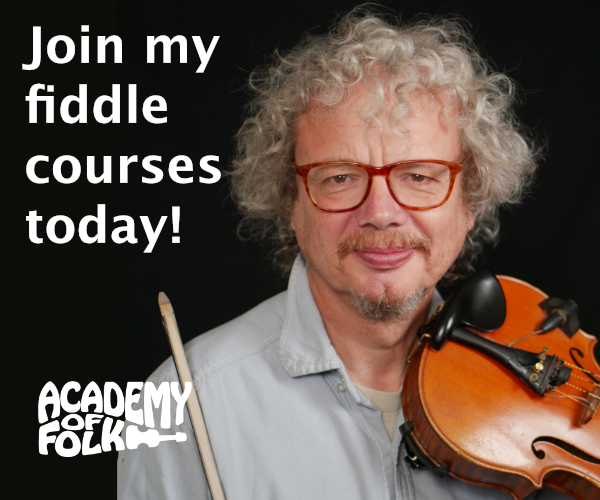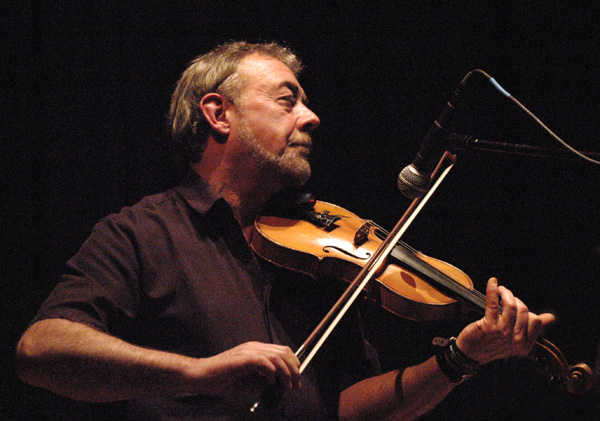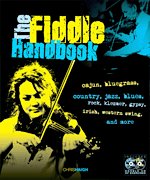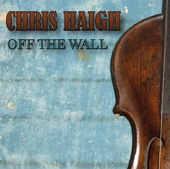
MENU TO FIDDLE STYLES:
Scottish Fiddle
PART ONE ; The History of Scottish Fiddle Music; PART TWO ; Regional fiddle styles in Scotland; PART THREE ; the music-tune types, modes, bowing and ornamentation; PART FOUR ; Contemporary Scottish Fiddle
4; 20thC and contemporary Scottish fiddlers
Scottish Fiddling in the 20th Century
The fiddle continued to be popular through the 20th Century, with Strathspey and Reel Societies being established in most Scottish cities. Meetings of such groups see large numbers of fiddlers playing unison, written arrangements of tunes. The fact that the majority of players read music (as is perhaps not the case among traditional players in Ireland), and the relatively sparse use of fingered ornamentation in the Scottish genre makes such unison playing a practical possibility. Fiddlers rallies have become popular- occasional or one-off events where even larger numbers of fiddlers (often up to 100) get together to play, and one such rally was the starting point for the Scottish Fiddle Orchestra. This ambitious project, launched in 1980, sees up to 150 amateur players of all ages performing before a conductor in concert halls throughout Scotland and abroad. Many, however, weaned on the traditional Irish pub session, with its marked informality, find such rallies, societies and orchestras anathema. Slightly less formal are the fiddle clubs which have sprung up throughout Scotland (where there are now over 50) and also in the US and Canada.
Scottish Fiddle Orchestra
Although fiddling is not as competitive in Scotland as in Ireland or the US, there is an equivalent to the Irish Comholtas festival/competitions. This is the Gaelic Mod, established in 1891 to preserve and promote Gaelic culture. There is a Royal National Mod, held annually, in a different location each year. Competitions include solo and choral singing and highland dancing as well as playing of the bagpipes, clarsach (harp) and fiddle. Despite having been originally started by a church choir, this hugely popular event has for some reason acquired the alternative title of the Whisky Olympics!
The link with dancing, always important with Scottish fiddling, was maintained through the 20th C with the rising popularity of Scottish country dancing, as exemplified by the Jimmy Shand group. With a typical line-up of fiddle, accordion, piano and drums, such groups perform for social dancing. This probably reached its peak in the 50’s and 60’s when “The White Heather Club”, presented by Andy Stewart, was a regular feature of BBC broadcasting, attracting up to 10 million viewers across Britain. The suffocating effect of accordion and drums left little room for expression or virtuosity on the part of the fiddler, and together with the straight-laced, och-aye-the-noo presentation, this is an aspect of Scottish music that leaves many fiddlers today with a shudder. Personally I have no shame; this year (and every year) on Burns night I’ll be scraping away to the Dashing White Sergeant, eating my haggis and wearing my tartan with the best of them.
The past 30 years have seen great strides forward in Scottish music. The general folk revival seen throughout Europe and America has coincided with a reawakening of nationalist sentiment in Scotland, and the newly independent administration has seen folk music as a handy and distinctive symbol of Scottish pride. Funding has therefore been available for grandiose classical/folk productions such as the accordionist Phil Cunningham’s “Highlands and Islands Suite”, incorporating the Scottish Chamber Orchestra, the Glasgow Phoenix choir, and a 30-piece Highland Fiddle Orchestra, as well as star fiddle soloists such as Aly Bain and Bruce McGregor.
Contemporary Scottish fiddling
The fiddle has been an essential part of most mainstream Scottish folk bands such as Runrig, Capercaillie and the Battlefield Band. John Cunningham blazed a fine trail with such bands as Silly Wizard and Relativity, whilst Alasdair Fraser is well known for his educational work as well as for the richly textured and panoramic arrangements and compositions of his group Skydance.
Aly Bain
Arguably the most famous contemporary Scottish fiddler is Aly Bain. Born in Shetland in 1946, he started playing at the age of 11, learning the traditional Shetland style from the great master Tom Anderson, and also developing an outstanding and distinctive technique. This includes a beautiful clear tone, a rich vibrato, and a mastery of the bouncing bowing . He has a particular talent for moving and emotional playing on slow airs and waltzes, but his show-stopping party piece is the all-action Hangman’s Reel or Le Reel Du Pendu- a mysterious tune in Norwegian Troll Tuning (AEAC#) featuring left hand pizzicato. After moving to the mainland in his early 20’s, he helped to form Boys of the Lough, a groundbreaking and highly successful group with whom he toured and recorded for over 30 years. He also has a longstanding partnership with ex-Silly Wizard accordionist Phil Cunningham. Among their many achievements together was being chosen to play for the opening of the new Scottish Parliament.
He has always had an interest in fiddle music from outside Scotland, and has presented numerous TV series which have acquired virtually cult status, including “Down Home”, exploring the links between Shetland fiddling and the various branches of American fiddling. This 1985 series featured relaxed and highly entertaining sessions where he played along with such stars as Mark O’Connor, Johnny Gimble and Junior Daugherty. Other series in a similar vein were Aly meets the Cajuns, The Shetland Sessions and The Transatlantic Sessions.
He is described back in his home town of Lerwick as “the best fiddle player in the world, possibly even in Shetland!”
The recent fertility of Scottish culture has produced many exotic blooms including The Easy Club, playing "Scottish Rhythm and Swing", Martyn Bennett ,who incorporates traditional fiddling and piping into modern trance and dance music, and the magnificent Shooglenifty, who have cornered the market in "hypnofolkadelic acid croft"
One of my favourites among Scotland's young contemporary fiddlers is Gordon Gunn. His spectacularly clean, fluid and imaginative playing can be heard to great effect on his Shoreside album with the Gordon Gunn Band, and also with Session A9, with which he tours regularly. What I find most exciting about his playing is the ease with which he incorporates elements of bluegrass and American contest-style fiddling into his performance without in any way compromising the integrity of what is still pure scottish music.
Gordon Gunn
PETE CLARK
The name of Niel Gow may not be as famous in fiddling circles as Scott Skinner, but Pete Clark is doing what he can to right the balance. He has created the Gow Ensemble with the aim of recreating the tunes, style and arrangements that Gow would have employed. At full strength the band fields six fiddles, two cellos, viola and piano, and creates a sound which strikes a happy medium between the refinement of 18thC classical music and the guts and energy of traditional Scottish fiddling. Clark was first hooked on the playing of Gow when a friend played him "Niel Gow's lament for the Death of his Second Wife". In 1990 , more by accident than design he found himself living in Birnam, near Gow's old stomping ground of Inver. He was offered the chance to try out Gow's fiddle, currently residing at Blair Castle, and soon after, around 1996, was asked by a local radio station to play the fiddle on air, as part of a fundraising campaign for the castle. He found it a delicate and sensitive instrument and with a lovely tone. It seemed a natural progression that he would then use the fiddle on his next album Even Now ( a reference to Gow's epitaph). As well as performing with his ensemble, Pete Clark also runs the Niel Gow Festival, and the annual Dunkeld Bridge Fiddle week.
Here's Pete Clark playing "Niel Gow's lament for the Death of his Second Wife"
Blazin' Fiddles
One of the most exciting recent developments in Scottish fiddling was the formation, in 1998, of Blazin’ Fiddles. Originally put together by Inverness fiddler Bruce MacGregor, it is a showcase for the different fiddle styles of the Highlands and Islands of Scotland. Joining him in the current line up is Shetlander Jenna Reid ( a protégé of Tom Anderson and Willie Hunter); Anna Massie from Fortrose, Alan Henderson from Mallaig, and Ian MacFarlane from Lochaber. Most of the line up are multi instrumentalists, so that a performance can include many different combinations and musical textures. Former members include Andy Thorburn, Catriona MacDonald, Duncan Chisholm, Aiden O’Rourke and Marc Clement. As well as widespread touring and five albums, the band is also known for its annual fiddle school, Blazin’ in Beauly, held each autumn near Inverness.
Blazin' Fiddles
Cape Breton
And so, finally to Cape Breton Island. Before you rush to the atlas, let me confirm that you're right, it's nowhere near Scotland! However, some of the finest Scottish fiddling is in fact found here.
It is a widely held view that in the 19th century Scottish fiddling was "cleaned up" by the joint forces of the Church (which temporarily banned it), the Government and Scott Skinner, leaving it elegant and stately, somewhat classical in approach, but with very little of the original ornamentation, bowing and healthy robustness. Fortunately Scots emigrants to Nova Scotia took the original style with them and have kept it alive and kicking to this day. The style is highly ornamented, uses mostly short single bows, and shows the influence both of highland bagpipes and Gaelic singing. It has an energetic, driving rhythm well suited to the accompaniment for dancing, and the fiddlers often sit down and tap their feet as an integral part of the music.
Players like Buddy MacMaster grew up playing strathspeys and reels for square dances, and only towards the end of his career was there sufficient outside interest for him to start recording or doing proper concert work. A 1972 CBC documentary, “The vanishing Cape Breton fiddler”, put forward the idea, hotly contested by some on the Island, that fiddling was dying out. In response a concerted effort was made to revitalise something that had perhaps been taken too much for granted. A Fiddlers Society was established, a fiddle festival, a “ceilidh trail” and since 1996 the Celtic Colours International Festival. Buddy’s niece Natalie MacMaster is one of a growing number of young fiddlers, along with cousins Wendy MacIsaac and Ashley MacIsaac (what the hell, it’s a small place!) who have had the benefit of a Cape Breton cultural revival, and found a ready market both at home, throughout Canada and abroad. Various artists, including Alisdair Fraser, have made successful efforts to re-introduce the Cape Breton style to Scotland, through concerts and workshops. Fraser states on his Driven Bow album of 1988; “Fortunately the fiddle and dance traditions of Cape Breton...provide us with a window which sheds light on the way 18th and 19th C dance fiddlers such as Niel Gow used to play in the highlands of Scotland…Let’s hope that some of the great fiddle and dance tradition that has been absent from Scotland for so many years can be restored”
Apart from the repertoire of reels and strathspeys, there are many stylistic similarities with the Scottish Highland and West coast style. As in the Highlands, players see a rhythmic link with the Gaelic language; it is a great compliment to be told you “have a lot of Gaelic in your playing”, though in the present generation there has been a great decline in use of the language. Open tunings such as ADAE are often used in long medleys of reels in the key of A, whilst DDAE is a good key for airs and strathspeys. Grace notes and drones can be traced back to the piping tradition. One distinctive feature of Cape Breton is that the piano has become an almost inseparable partner to the fiddle, with a busy chromatic and syncopated style.
Natalie MacMaster
_______________________________________________________________________________
Check out my London-based Ceilidh band QUICKSILVER
Chris Haigh is a London-based fiddle player. He plays many styles, but has a large repertoire of Scottish fiddle tunes, which he plays either solo (for private functions) or with his ceilidh band Quicksilver. He has appeared at the Edinburgh Folk Festival, the Glasgow Celtic Connections festival, and five times at the Shetland Folk Festival. He has written and recorded a cd of tunes in Scottish traditional style for use as TV production music; tracks from this album have appeared on programmes throughout the world.
Links:
- Article on Neil Gow
- Alasdair Fraser's Fiddle Camps
- Article on Scott Skinner
- A synopsis of Peter Cooke's book on Shetland fiddling
- Scottishfiddling.org
- Scottish fiddle.com (An excellent new resource including sheet music downloads)
- Catherine Fraser (Australian based Scottish fiddler)
- Linda Rankin (another Scots fiddler based in Australia)
- Scotchsnap.com (good online source for Scottish sheet music)
- Taransay Fiddlers (week- long fiddle course on a Hebridean island)
RETURN TO FIDDLINGAROUND HOMEPAGE



